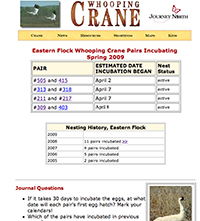Today's Report Includes:
- Class of 2008: Everybirdy's Headed Home >>
- News: Reports
and Photos From the Field >>
Lesson: A Day in the Life of a Migrating Whooper >>
- Journal Topic: Nesting! >>
- Slide Show: Meet Al and Diane >>
-
Links: This Week's Crane Resources >>
Photo
Sara Zimorski
What are 3 interesting things about this pair? |
The Chass release site in Florida is empty! Juveniles #803, 824, and 827, the three that stayed behind when their four classmates left on March 24, began migration April 4. All of the Class of 2008 is headed to Wisconsin, where some of the adult crane pairs are already nesting! After the wonder of migration, everyone hopes the next miracle will be baby chicks!
|
Photo USFWS |

|
|
|
Western
Flock News>> |
How
many Whooping cranes from the Eastern flock are back in Wisconsin?
Count them at the Finish Line. Over half of
the wild cranes of the Western flock are now in the Central
Flyway. See the latest migration map! >> |
Eastern
Flock News>> |
Already 8 nests hold the promise of new chicks. Dig into our chart to answer this week's questions:
- View the chart and calculate: When might the each nest hatch if the cranes nest successfully?
- If you were a scientist who could focus a Web cam on the crane nests in Wisconsin, what would you watch for? What would you hope to learn? (Before answering, see the link to the 2008 nesting summary. >>)
- What would you need to know in order to make a prediction about this year's nesting success in the Eastern flock? In the Western flock?
Write your
responses in your Journal. >>
Slide Show >>
Female cranes tend to be picky in their choice of a mate. Unless they meet a compatible male, female cranes will not lay eggs. This makes sense because crane pairs work as a team. Together they share all the duties: defending the territory, building the nest, incubating the eggs, and raising the chicks.
Tom Stehn tells us about a remarkable crane pair in the natural flock that has brought more chicks to Aransas than any crane pair ever. How many chicks? How often? How did this pair come to be called Al and Diane? From Tom's rich memories and knowledge of the flock come great stories. You'll like this one: Meet Al and Diane!
Meet Al and Diane: The Flock's Most Productive Cranes >>
- Current Events: #826's Injury >>
- Lesson: A Day in the Life of a Migrating Whooper >>
- Western Flock News: >>
- Eastern Flock News: >>
- The Finish Line: Wisconsin Arrivals >>
- Nesting Chart: Spring 2009, Eastern Flock >>
- Last Year's Nesting Summary: >>
- Slide Show: Meet Al and Diane, Productive Pair >>
- Audio Clip: Brian Talks About Nesting in Canada >>
- Video Clip: Whooper Family at Nebraska Migration Stopover >> (Joel Jorgensen, Nongame Bird Program Manager at NE Game and Parks Commission)
- Mapping and Record Keeping: Track the Migration >>
- Meet
Student Craniacs: Classrooms in Action >>
The Next Whooping Crane Migration Update Will Be Posted on April 17, 2009.









